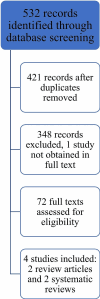Incorporating patient-reported outcome measures (PROMs) into a clinical quality registry (CQR) for ovarian cancer: considerations and challenges
- PMID: 38978033
- PMCID: PMC11232149
- DOI: 10.1186/s12913-024-11042-8
Incorporating patient-reported outcome measures (PROMs) into a clinical quality registry (CQR) for ovarian cancer: considerations and challenges
Abstract
As medical treatment increasingly focuses on improving health-related quality of life, patient-reported outcome measures (PROMs) are an essential component of clinical research. The National Gynae-Oncology Registry (NGOR) is an Australian clinical quality registry. A suitable PROM was required for the NGOR ovarian cancer module to complement clinical outcomes and provide insights into outcomes important to patients. Our narrative review aimed to identify existing ovarian cancer-specific PROMs and ascertain which tool would be most appropriate for implementation into the NGOR ovarian cancer module.A literature review of Cochrane Library, Embase, MEDLINE and PubMed databases was performed to identify existing ovarian cancer-specific PROM tools. A steering committee was convened to (1) determine the purpose of, and criteria for our required PROM; and (2) to review the available tools against the criteria and recommend the most appropriate one for implementation within the NGOR.The literature review yielded five tools: MOST, EORTC QLQ-OV28, FACIT-O, NFOSI-18 and QOL-OVCA. All were developed and validated for use in clinical trials, but none had been validated for use in clinical quality registry. Our expert steering committee pre-determined purpose of a PROM tool for use within the NGOR was to enable cross-service comparison and benchmarking to drive quality improvements. They identified that while there was no ideal, pre-existing, ovarian cancer-specific PROM tool for implementation into the NGOR, on the basis of its psychometric properties, its available translations, its length and its ability to be adapted, the EORTC tool is most fit-for-purpose for integration into the NGOR.This process enabled identification of the tool most appropriate to provide insights into how ovarian cancer treatments impact patients' quality of life and permit benchmarking across health services.
Keywords: Clinical quality registry; Gynaecological cancer; Ovarian cancer; Patient reported outcome measures; Quality of life.
© 2024. The Author(s).
Conflict of interest statement
Yael Lefkovits: Nil to declare. Natalie Heriot: Nil to declare. Alice Sporik: Nil to declare. Sharnel Perera: Nil to declare. Michael Friedlander: Nil to declare. Cyril Dixon: Nil to declare. Yeh Chen Lee: Nil to declare. Simon Hyde: Nil to declare. Gary Richardson: Nil to declare. Penelope Webb: Received grant funding from AstraZeneca for an unrelated study of ovarian cancer. Paul A Cohen: Speakers’ honoraria from Astra Zeneca. Robert Rome: Nil to declare. Madeleine King: Nil to declare. John Zalcberg: Nil to declare. Penelope Schofield: Nil to declare.
Figures
Similar articles
-
Implementation of patient-reported outcome measures and patient-reported experience measures in melanoma clinical quality registries: a systematic review.BMJ Open. 2021 Feb 11;11(2):e040751. doi: 10.1136/bmjopen-2020-040751. BMJ Open. 2021. PMID: 33574144 Free PMC article.
-
Patterns of care and development of quality indicators in patients with non-epithelial and rare ovarian tumors in Australia: insights from the National Gynae-Oncology Registry.Int J Gynecol Cancer. 2025 Feb;35(2):100052. doi: 10.1016/j.ijgc.2024.100052. Epub 2024 Dec 12. Int J Gynecol Cancer. 2025. PMID: 39971437
-
Developing an Australian multi-module clinical quality registry for gynaecological cancers: a protocol paper.BMJ Open. 2020 Feb 27;10(2):e034579. doi: 10.1136/bmjopen-2019-034579. BMJ Open. 2020. PMID: 32111617 Free PMC article.
-
Assessing quality of life in palliative care settings: head-to-head comparison of four patient-reported outcome measures (EORTC QLQ-C15-PAL, FACT-Pal, FACT-Pal-14, FACT-G7).Support Care Cancer. 2020 Jan;28(1):141-153. doi: 10.1007/s00520-019-04754-9. Epub 2019 Apr 16. Support Care Cancer. 2020. PMID: 30993452
-
Standardising the Assessment of Patient-reported Outcome Measures in Localised Prostate Cancer. A Systematic Review.Eur Urol Oncol. 2022 Apr;5(2):153-163. doi: 10.1016/j.euo.2021.10.004. Epub 2021 Nov 14. Eur Urol Oncol. 2022. PMID: 34785188
Cited by
-
Successful laparoscopic cytoreductive surgery for multiple (three) advanced recurrences of AGCT in a young woman. A case report.Int J Surg Case Rep. 2025 Feb;127:110960. doi: 10.1016/j.ijscr.2025.110960. Epub 2025 Jan 27. Int J Surg Case Rep. 2025. PMID: 39874807 Free PMC article.
References
Publication types
MeSH terms
LinkOut - more resources
Full Text Sources
Medical
Research Materials


